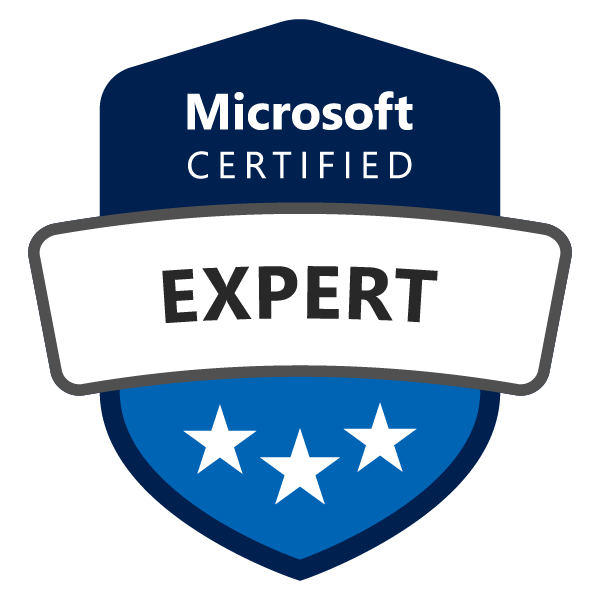Azure Solutions Architect Expert
Microsoft Certified:
Azure Solutions Architect Expert
Microsoft Azure Solutions Architects must have expertise in compute, network, storage, and security so that they can design solutions that run on Azure.

Recommended approach
Step 1: Review the skills and knowledge required to certify.
Step 2: Train for certification exams.*
Step 3: Take a practice exam
- Microsoft Official Practice Tests are coming soon
Step 4: Schedule your exams and get certified
- Schedule to take Exam AZ-300
- Schedule to take Exam AZ-301
- Schedule to take Exam AZ-302 (transition exam for people who passed Exam 70-535)
*Classroom and online training options will be added when available.
Start by Proving that You Know the Fundamentals
Just starting in technology, thinking about a career change, or want to explore one of the technologies that will drive digital transformation in organizations? Prove that you have the basic knowledge to get started with an optional Fundamentals certification exam.

Exam AZ-900: Microsoft Azure Fundamentals
Validate that you know the fundamentals of Azure
Required exams

Exam AZ-300: Microsoft Azure Architect Technologies

Exam AZ-301: Microsoft Azure Architect Design

Exam AZ-302: Microsoft Azure Solutions Architect Certification Transition
This exam is intended only for candidates who have taken Exam 70-535: Architecting Microsoft Azure Solutions. If you have not taken Exam 535, you will not earn a certification by taking this exam.
Skills and knowledge
Candidates who earn an Azure Solutions Architect certification are verified by Microsoft to have the following skills and knowledge.
- Deploy and Configure Infrastructure
- Implement Workloads and Security
- Create and Deploy Apps
- Implement Authentication and Secure Data
- Develop for the Cloud and for Azure Storage
- Determine Workload Requirements
- Design for Identity and Security
- Design a Data Platform Solution
- Design a Business Continuity Strategy
- Design for Deployment, Migration, and Integration
- Design an Infrastructure Strategy
Analyze resource utilization and consumption
- configure diagnostic settings on resources
- create baseline for resources
- create and rest alerts
- analyze alerts across subscription
- analyze metrics across subscription
- create action groups
- monitor for unused resources
- monitor spend
- report on spend
- utilize Log Search query functions
- view alerts in Log Analytics
Create and configure storage accounts
- configure network access to the storage account
- create and configure storage account
- generate shared access signature
- install and use Azure Storage Explorer
- manage access keys
- monitor activity log by using Log Analytics
- implement Azure storage replication
Create and configure a Virtual Machine (VM) for Windows and Linux
- configure high availability
- configure monitoring, networking, storage, and virtual machine size
- deploy and configure scale sets
Automate deployment of Virtual Machines (VMs)
- modify Azure Resource Manager (ARM) template
- configure location of new VMs
- configure VHD template
- deploy from template
- save a deployment as an ARM template
- deploy Windows and Linux VMs
Implement solutions that use virtual machines (VM)
- provision VMs
- create ARM templates
- configure Azure Disk Encryption for VMs
Create connectivity between virtual networks
- create and configure VNET peering
- create and configure VNET to VNET
- verify virtual network connectivity
- create virtual network gateway
Implement and manage virtual networking
- configure private and public IP addresses, network routes, network interface, subnets, and virtual network
Manage Azure Active Directory (AD)
- add custom domains
- configure Azure AD Identity Protection, Azure AD Join, and Enterprise State Roaming
- configure self-service password reset
- implement conditional access policies
- manage multiple directories
- perform an access review
Implement and manage hybrid identities
- install and configure Azure AD Connect
- configure federation and single sign-on
- manage Azure AD Connect
- manage password sync and writeback
No comments:
Post a Comment